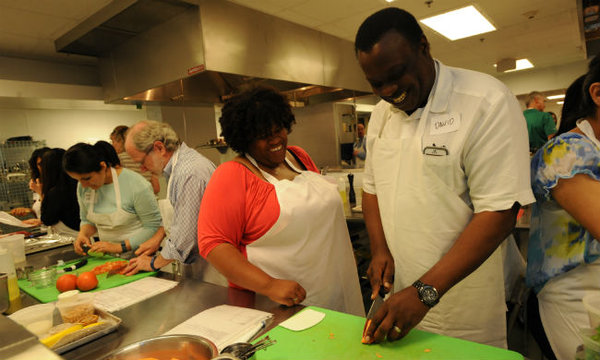At Tulane’s Goldring Center for Culinary Medicine, students are learning to pair nutrition with allopathic care—and other schools are catching on.
The United States has seen the rise of chronic diseases and certain cancers, but it may soon see the rise of healthier diets.
“When we see healthier eating, we see more disease prevention and less hospital stays, which means less money spent on healthcare,” says Leah Sarris, chef and program director of The Goldring Center for Culinary Medicine at Tulane University, where medical students are learning to cook to better advise the health of their patients. By getting them to approach food preparation with ease and awareness, this next generation of doctors is striving to provide building blocks for long-term health management.
Started in 2012, the program couldn’t have come at a more crucial time. In 2010, chronic disease accounted for 86 percent of all healthcare spending; four years later, the cost of treating heart disease alone totaled $315.4 billion, including medication and hospital care.
Although people have used food as medicine for centuries, the educational programming for it has not been around as long. In the U.S., The Goldring Center’s culinary curriculum is the first of its kind.
Students complete eight classes that are three hours each, earning a total of 24 hours of in-class culinary practice. Fourth-year students can choose from seminars that focus on different clinical interests, including celiac disease, inflammatory bowel disease, food allergies, diabetes, pregnancy, and neurocognition.
Students also teach free cooking classes to the public. Because medical students are being trained to prescribe healthy eating to their patients, Sarris says, the community classes are essential to their learning. Medical students volunteer and teach participants cooking techniques for healthier eating.
Serving around 600 community members a year, the weekly classes fill up fast; the waiting list hovers around 300. They range from beginner to advanced, and each series is organized into eight to 12 classes over two to three months.
“The hands-on component gets people to talk about food instead of nutrients. Food is something that unites us and we can all understand,” Sarris says.
Lori Neupert, a local, took the beginner and intermediate series last year, and liked how the beginner class centered around “breaking down the barrier for people who are intimidated about going into the kitchen and preparing a nutritious meal. [You learn] how to feed and enjoy yourself.”
She felt especially motivated after learning how to chop an onion, grate ginger, and sauté fish. “When you prepare your own food, you’re in control of your salt and sugar intake. Processed food is loaded with that stuff,” Neupert observes.
The community classes also provide a space for low-income people to learn how to cook, budget their money, manage their time, and enjoy healthy meals.
“Our goal is that our recipes are all under $2.50 a portion. We are able to keep a low budget by [using] less meat and processed foods, more legumes, grains, and seasonal fruits and vegetables,” says Sarris.
She and the medical students educate about “foods that hold well,” like onions, sweet potatoes, and frozen fruits and veggies. These are foods that people can use in a variety of ways and over a long period of time, saving money and trips to the supermarket.
Dennis Ren, a fourth-year medical student at Tulane, explains that learning how to cook empowers the community and his patients with simple, practical tools. “Lots of people don’t eat well because they don’t know how to cook.”
Ren feels confident about using practical advice to develop a course of care for his patients.
“If I had a patient with congestive heart failure, I would prescribe them the medication they need. I would also try to lessen their salt intake. But I understand that salt tastes really good. I would keep the savory flavor by encouraging them to use lemon instead, [which] activates the same receptor on the tongue,” he says.
This integrative understanding of healthcare may change the way it is structured.
“In five years, your doctor might prescribe you a cooking class, and healthcare companies will pay for that,” says Sarris.
About 20 medical schools have adopted Tulane’s program, including UCLA Clinical and Translational Science Institute, University of Illinois-Chicago, and Kendall College School of Culinary Arts.
Last year, Renee Zonka, teaching chef and associate dean at Kendall, spearheaded its pilot culinary medicine program. She predicts an impact on family and culture. “[Doctors and their patients] may try something different—they may choose to eat and cook a little healthier, promoting better health for them and their families in ways that still fit with their lifestyles and cultures,” she says.
More and more, diet is becoming a mode of preventative care. By cooking healthy meals, patients are better able to fight disease—while enjoying themselves in the kitchen.
Source: Yes! Magazine
Photo: Paula Burch-Celentano
